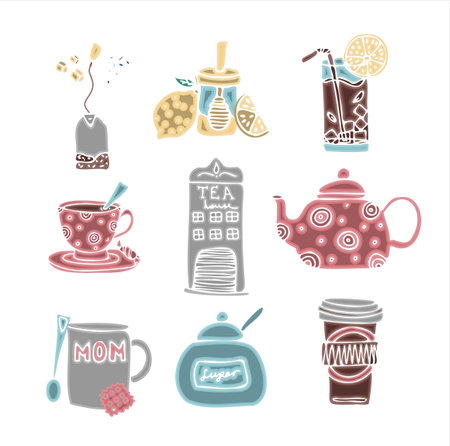Introduction: The Changing Landscape of British Coffee Culture
In recent years, the British café scene has undergone a remarkable transformation, blending longstanding traditions with contemporary tastes. Historically, cafés in the UK have served as quintessential meeting places, where a classic cup of tea or a freshly brewed filter coffee accompanied conversations and daily rituals. The local high street café was less about coffee innovation and more about comfort, familiarity, and community spirit. However, the tides are shifting as the palette of British consumers evolves—especially among younger generations who seek variety and international influences in their daily caffeine fix. One of the most notable trends to emerge is the surge in popularity of iced coffee beverages. No longer limited to continental Europe or American franchises, iced coffees have found a firm foothold on British high streets, becoming a staple on menus from independent artisan cafés to established chains. This evolution marks not just a change in drink preference but signals a broader adaptation within British café culture, reflecting both globalisation and the nation’s readiness to embrace new coffee experiences alongside its cherished traditions.
Local High Streets: Community Hubs and Coffee Evolution
High streets have long been the beating heart of British communities, acting as vibrant social and cultural meeting points. These bustling thoroughfares are more than just a collection of shops; they encapsulate the spirit of local life, where neighbours meet, conversations spark, and traditions evolve. In recent years, high street cafés have undergone a significant transformation, adapting their offerings to suit the dynamic tastes of a diverse clientele while maintaining their role as essential communal spaces.
The evolution of coffee menus on British high streets is closely tied to shifting consumer preferences and broader cultural trends. The classic cup of tea or traditional hot coffee now sits alongside an array of innovative beverages, with iced coffee rapidly gaining popularity. This shift is driven by multiple factors: changing weather patterns, increased exposure to global café trends through travel and social media, and a growing younger demographic seeking refreshing alternatives.
Factors Influencing Menu Innovation
| Factor | Impact on High Street Cafés |
|---|---|
| Changing Consumer Demographics | Younger generations favouring chilled beverages and customisation options. |
| Global Influences | Exposure to American, Australian, and European café cultures inspiring new menu items. |
| Climate Considerations | Milder summers increasing demand for cold drinks. |
| Social Media Trends | Iced coffee’s aesthetic appeal driving online engagement and footfall. |
| Health Consciousness | Diversification into sugar-free syrups and plant-based milk alternatives for iced drinks. |
Cafés along British high streets are therefore not only places to grab a quick caffeine fix but also function as adaptive spaces reflecting the evolving cultural landscape. Whether it’s students revising over a cold brew or friends catching up with an oat milk iced latte in hand, these venues facilitate interaction and foster community identity. The expansion of iced coffee menus can thus be seen as both a response to market demand and a symbol of the UK’s increasingly cosmopolitan palate.

3. Iced Coffees Rise: Seasonal Trends and Consumer Preferences
The surge in iced coffee offerings across British high streets is closely linked to the nation’s shifting weather patterns and changing consumer behaviours. With the UK experiencing warmer summers and milder springs in recent years, cafés have responded by adapting their menus to meet the growing appetite for chilled beverages. The traditional image of the British public clutching a steaming mug of tea or coffee has evolved; today, it’s not uncommon to see customers strolling down Oxford Street with an expertly brewed iced latte in hand.
Seasonal Influences on Beverage Choices
As temperatures climb, particularly during late spring and summer, footfall in cafés tends to increase, with patrons actively seeking out refreshing alternatives to hot drinks. This seasonal shift has prompted café owners to innovate, offering everything from classic iced Americanos to more elaborate cold brews infused with citrus or botanicals. For many Britons, iced coffee is no longer just a novelty—it’s become a staple of their summer routines, often enjoyed al fresco on bustling pavements or leafy park benches.
Evolving Consumer Palates
The British palate has also become more adventurous, shaped by global travel and exposure to international coffee trends. Younger generations, in particular, are driving demand for customisable options—think oat milk flat whites poured over ice or caramel frappés topped with whipped cream. These preferences reflect a broader desire for variety and personalisation, as well as an increasing awareness of health and dietary considerations.
The Shift Towards Lighter, More Refreshing Flavours
Beyond mere temperature preference, consumers are gravitating towards lighter flavour profiles that complement Britain’s intermittent sunshine. Fruity cold brews, sparkling espresso tonics, and nitrogen-infused coffees are now regular fixtures on menus in both independent cafés and major chains alike. This trend signals not only a shift in taste but also a deeper appreciation for the craft of coffee making—where roasting profiles and bean origins are carefully selected to shine when served over ice.
4. Menu Diversification: British Twists on Classic Iced Coffees
As iced coffee has become an established part of British café culture, local establishments have begun to infuse classic cold coffee recipes with uniquely British characteristics. This menu diversification goes beyond simply offering a standard iced latte or americano; instead, it celebrates the UK’s rich culinary heritage and regional preferences. By thoughtfully sourcing beans, blending innovative ingredients, and adapting to British tastes, cafés are redefining what iced coffee means on the high street.
Sourcing Beans with Provenance
British cafés increasingly highlight the provenance of their coffee beans, often selecting single-origin options from ethical suppliers. The emphasis is not just on sustainability but also on flavour profiles that suit the British palate—favouring notes of chocolate, caramel, and subtle fruit over brighter, acidic coffees more popular elsewhere. Some independent roasteries even offer bespoke blends tailored to complement milk-heavy iced drinks or to shine in cold brew extractions.
Integrating Distinctly British Flavours
One of the most exciting developments is the incorporation of flavours traditionally associated with British desserts and beverages. From Earl Grey and English breakfast tea infusions to syrups inspired by Bakewell tart or sticky toffee pudding, these twists make iced coffee feel instantly familiar yet refreshingly new. Even seasonal specials—such as rhubarb compote swirls in summer or spiced apple syrup in autumn—reflect local produce and festive traditions.
Examples of British-Inspired Iced Coffee Variations
| Iced Coffee Style | British Twist |
|---|---|
| Iced Flat White | With oat milk and a hint of honey from local apiaries |
| Iced Americano | Earl Grey-infused espresso over ice, garnished with lemon zest |
| Iced Mocha | Blended with dark chocolate and a dash of sea salt from Cornwall |
| Cold Brew | Finished with a splash of elderflower cordial for a floral lift |
Catering to Regional Preferences
Cafés across the UK also account for regional nuances in taste. In Scotland, for example, you may find iced coffee sweetened with heather honey or topped with tablet crumb. In the West Country, clotted cream cold foam might crown your drink. These adaptations not only delight local customers but also intrigue visitors seeking an authentically British experience.
The Role of Tradition and Innovation
This blend of tradition and innovation is at the heart of British café culture’s approach to iced coffee. By paying homage to local ingredients and customs while embracing global trends, UK high streets are creating menus that are both forward-thinking and deeply rooted in their communities. As a result, each glass tells a story—not just of global coffee evolution but also of British identity and ingenuity.
5. Barista Perspectives: Technical Challenges in Preparing Iced Beverages
As iced coffee becomes increasingly prevalent on British high streets, the expertise and insights of baristas have become central to ensuring quality and consistency. The move towards more complex iced coffee recipes has introduced a unique set of technical challenges that go beyond those faced in traditional hot beverage preparation.
Water Quality: The Unsung Ingredient
Baristas across the UK emphasise the importance of water quality when crafting iced beverages. Unlike hot coffee, where temperature can mask subtle impurities, iced coffees are far less forgiving. The use of filtered water is essential, not only for brewing espresso but also for making ice cubes that do not impart unwanted flavours or odours. Some cafés on the high street have even invested in specialist filtration systems to guarantee purity, with baristas noting that good water allows the nuanced notes of single-origin espressos to shine through, even when chilled.
Espresso Extraction: Timing and Technique
Perfecting espresso extraction for iced drinks requires a precise approach. Baristas report that over-extraction or under-extraction can be exaggerated by dilution when espresso is poured over ice. Many recommend pulling slightly stronger shots or using a finer grind to preserve intensity after ice is added. This ensures the drink remains robust and aromatic, aligning with British preferences for well-balanced flavours rather than overly sweet or weak concoctions commonly found elsewhere.
Adaptation to Local Palates
The British palate often seeks a harmonious balance between bitterness and sweetness, which means baristas must carefully adjust espresso ratios and milk choices. Oat milk, for example, has surged in popularity due to its creamy texture and ability to complement both the espresso and the chill of ice.
Customer Education: Bridging Expectations
With iced coffee still relatively novel in many parts of Britain, baristas find themselves guiding customers through their options. Explaining differences between cold brew, iced lattes, and other variants is now part of daily service. Some cafés have developed tasting flights or educational displays to help customers appreciate how factors like grind size, brew time, and even ice cube shape impact flavour. This educational approach reflects a broader trend in British café culture—valuing transparency and craftsmanship alongside convenience.
A Collaborative Journey
Ultimately, baristas on local high streets see themselves as both artisans and educators. Their ongoing dialogue with customers and commitment to refining technique are key drivers behind the successful integration of iced coffee into Britain’s café scene. As demand grows, these technical skills—and the willingness to innovate—are likely to shape the future of British café culture for years to come.
6. Market Response: The Role of Chains and Independent Cafés
The rapid rise in iced coffee’s popularity across British high streets has prompted distinct responses from both major coffee chains and independent cafés. These two sectors are navigating the shift with unique strategies that reflect their brand identities, resources, and relationships with local communities.
Large Coffee Chains: Standardisation and Scale
Leading brands such as Costa Coffee, Starbucks, and Caffè Nero have embraced the iced coffee trend with characteristic efficiency. Their approach hinges on standardised recipes, streamlined service, and broad marketing campaigns to ensure consistency across hundreds of locations nationwide. This allows chains to introduce seasonal iced drinks, flavour infusions, and limited-edition offerings at scale. For example, during summer months, large chains frequently launch nationwide promotions for cold brews, frappés, and dairy-free alternatives, leveraging their established supply chains and digital ordering platforms to capture peak demand.
Adaptation through Menu Expansion
These chains also utilise customer data analytics to refine their iced coffee menus based on regional preferences—introducing plant-based milks or reduced-sugar syrups in response to evolving consumer health trends. By integrating iced beverages into loyalty programmes and mobile apps, they further encourage regular visits and experimentation among their customer base.
Independent Cafés: Artisanal Innovation and Community Focus
Conversely, independent cafés on British high streets have responded to the iced coffee phenomenon with a focus on craftsmanship and local flair. Many smaller establishments see iced coffee not just as a summer staple but as an opportunity to showcase single-origin beans, house-made syrups, or innovative brewing methods like Japanese-style flash-chilling or slow-drip cold brew. These efforts often result in a more bespoke experience that appeals to discerning customers seeking quality over quantity.
Building Local Loyalty
Independents frequently collaborate with local roasters or use ethically sourced beans to differentiate themselves from larger competitors. Seasonal specials—such as iced lattes infused with British berries or herbal notes—highlight regional ingredients while fostering a sense of community identity. Social media plays a crucial role here; independents use Instagram-worthy presentations and behind-the-scenes content to engage local audiences and build loyal followings.
Balancing Tradition with Trend
Despite resource limitations compared to the big chains, many independent cafés thrive by offering personalised service and educating customers about the nuances of their iced coffee creations. This hands-on approach helps bridge traditional British café culture with contemporary global trends—ensuring that each cup served is both familiar and fresh.
7. Conclusion: The Future of Iced Coffee in British Café Culture
The steady rise of iced coffee across Britain’s local high streets is more than a fleeting trend—it marks a significant evolution within the nation’s café culture. As British tastes become increasingly cosmopolitan and consumers embrace a wider variety of brewing methods, iced coffee has secured its place alongside traditional favourites like the flat white and builder’s tea. Looking ahead, the continued expansion of iced coffee menus suggests that cafés will need to remain agile, adapting their offerings to cater for both seasonal demand and a new generation of coffee drinkers seeking refreshing alternatives.
This shift holds broader implications for café operators and the industry at large. Menu diversification encourages innovation not only in beverage preparation but also in sourcing beans, experimenting with roast profiles, and even reconsidering how cold drinks are presented and served—think locally inspired syrups or environmentally conscious packaging. Moreover, the popularity of iced coffee signals an embrace of global coffee culture while retaining a distinctly British flair, such as pairing cold brews with classic pastries or incorporating local ingredients.
Ultimately, the integration of iced coffee into daily routines reflects the adaptability and openness of British café culture. It offers opportunities for community connection on bustling high streets, supports local businesses in meeting shifting consumer preferences, and redefines what it means to enjoy a cup of coffee in Britain—whether rain or shine. As we look to the future, one thing remains clear: iced coffee is here to stay, shaping the next chapter of Britain’s love affair with all things coffee.


